Vogelherdhöhlen
Vogelherd Caves
Useful Information

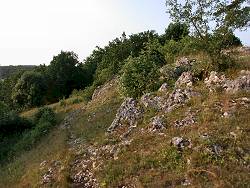

| Location: |
89168 Niederstotzingen.
A7 exit Niederstotzingen, follow the road through Niederstotzingen, 2 km after the town at the turnoff to Lontal. (48.558776, 10.194135) |
| Open: |
closed. [2023] |
| Fee: |
free. [2023] |
| Classification: |
 Karst cave Karst cave
 Collapsed Cave Collapsed Cave
|
| Light: | none, not really necessary, but bring torch. |
| Dimension: |
(Große) Vogelherdhöhle: L=39 m, B=7 m, H=3.8 m, 480 m asl Kleine Vogelherdhöhle: L=42 m, B=7 m, H=2.5 m, 438 m asl |
| Guided tours: | self guided |
| Photography: | allowed |
| Accessibility: | no |
| Bibliography: |
Gustav Riek (1934):
Die Eiszeitjägerstation am Vogelherd im Lonetal,
Bd. I: Die Kulturen. Leipzig, Kabitzsch

Gustav Riek (1935): Kulturbilder aus der Altsteinzeit Württembergs. Tübingen, Franz F. Heine. 
Gustav Riek (1951): Die Mammutjäger vom Lonetal. Stgt., Thienemanns. 
|
| Address: |
Stadt Niederstotzingen, Im Städtle 26, 89168 Niederstotzingen, Tel: +49-7325-102-0, Fax: +49-7325-102-26.
E-mail: Stadtverwaltung Langenau, Rathaus, Marktplatz 1, 89129 Langenau, Tel: +49-7345-9622144, Fax: +49-7345-9622155. E-mail: Guided Walks: Hermann Häußler, Achstraße 44 a, 89129 Langenau, Tel: +49-7345-6719, Cell: +49-172-7848347. E-mail: |
| As far as we know this information was accurate when it was published (see years in brackets), but may have changed since then. Please check rates and details directly with the companies in question if you need more recent info. |
|
History
| 1931 | discovered by the local historian H. Mohn from Heidenheim. |
| 1931 to 1934 | excavations by Gustav Riek, an archaeologist from Tübingen. |
| 2005 to 2012 | archaeological excavation of the slag heap. |
| 2013 | Archäopark Vogelherd opened to the public. |
| 2017 | inscribed on the UNESCO World Heritage List. |
| 2022 | Archäopark Vogelherd permanently closed. |
Description
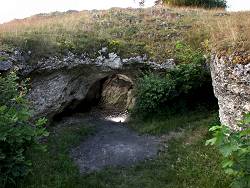
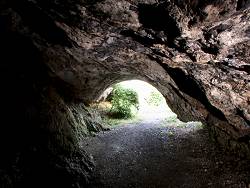
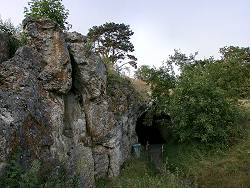
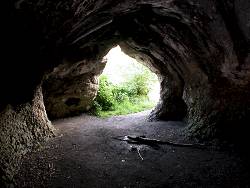
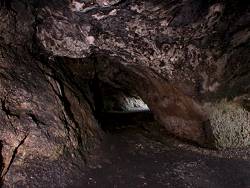
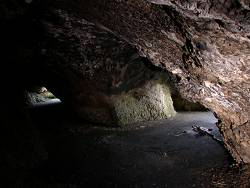
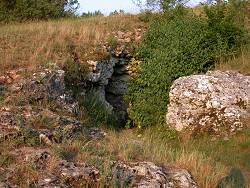

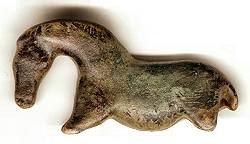
The Vogelherd Caves are two small and unspectacular caves, only a few meters long. They are not interesting from the speleological or geological point of view. But they are world-famous for the archaeological finds made here.
The Big Vogelherd Cave has three entrances, two of them are high enough to walk through upright. The third one is rather low, and most visitors do not even mention it. Most of the cave is rather spacious, and it was used by the local youth for parties, which was not exactly allowed. However, it shows how useful the cave is as a shelter. It has ever been and as a result it was frequented by prehistoric hunters.
The Small Vogelherd Cave is much smaller. The entrance is high enough to walk in upright, but after only four meters, the cave becomes very low. The entrance is a little concealed at the side of a rock, and the first part of the cave turns sharp right, which makes the cave invisible from the outside, and the outside invisible from the cave. The cave is rather easy to find, as a trail leads to the entrance.
In the Lone Valley, there is a small parking area for hikers at the turn-off from the local road between Bissingen and Stetten in the direction of Hürben. From here you can reach the Vogelherd caves in about 10 minutes by following the trail uphill. In 2017, the Lone Valley and the Blau Valley with all the caves with prehistoric finds were listed on the UNESCO World Heritage List. The monuments listed there must, as part of the rules, be accessible to visitors and explanations must be given about the background. This is a double-edged sword; on the one hand, it is welcome that the entry in the list does not lead to cultural assets being locked away and accessible only to an elite. On the contrary, in many cases it has already led to cultural assets being made accessible in a meaningful way, and thus knowledge about them is now imparted to a broad population. And in addition, cultural assets that were previously freely accessible and exposed to vandalism have been protected from further destruction by official opening hours and guided tours.
With this in mind, a so-called Archäopark was set up here at Vogelherd. This concept comes from France, and is primarily based on imparting knowledge about life in prehistoric times through the possibility of trying out various activities for oneself. These include things like lighting a fire, striking a flint, shooting an arrow or throwing a spear. All these things have been researched in the context of experimental archaeology and are not only demonstrated here, but taught. Certainly an interesting thing to do, especially for children and school classes. The municipality of Niederstotzingen, which financed the Archäopark, would certainly not be unhappy about income that would benefit the suffering municipal coffers.
Unfortunately, the Germans don't seem to be quite so enthusiastic about this concept. Add to that the lockdowns by Corona, and the Archäopark was already broke after less than 10 years and was permanently closed. Unfortunately, no one took down the fences that enclosed the site. And so today the caves are no longer accessible at all. It was already borderline to charge double-digit entrance fees for the caves before, especially if you weren't interested in experimental archaeology. But to keep the caves permanently closed is, in our opinion, blatantly contrary to UNESCO's guidelines.
Artworks from Vogelherd Caves
The Vogelherd Caves were used as a shelter by Stone Age hunters for a very long time, during the Ice Ages. The oldest remains found in the caves are from the Acheuléen (after Riek). The most beautiful finds are some small ivory figurines from the Aurignacien. There are carvings of mammoth, ren, wild horse, bison, bear, panther und cave lion.
Dating using modern physical methods, like
 C14-dating, dated the ivory carvings to nearly 40.000 years before present.
So the figures of the Vogelherd Caves are the oldest known artworks of the world.
C14-dating, dated the ivory carvings to nearly 40.000 years before present.
So the figures of the Vogelherd Caves are the oldest known artworks of the world.
The original carvings, sometimes only good replicas, are on display in archaeological museums of the region.
The best archaeological exhibition is in the
 Ulmer Museum
(Museum of Ulm).
Another interesting exhibition is in the Universitätssammlungen (University Collections) in the Tübinger Schloß (Castle of Tübingen).
Ulmer Museum
(Museum of Ulm).
Another interesting exhibition is in the Universitätssammlungen (University Collections) in the Tübinger Schloß (Castle of Tübingen).
- See also
 Ulmer Museum
Ulmer Museum Subterranean World Heritage List
Subterranean World Heritage List The Oldest Archeological Remains Found in Caves
The Oldest Archeological Remains Found in Caves Google Earth Placemark
Google Earth Placemark Vogelherd Cave - Wikipedia (visited: 07-AUG-2023)
Vogelherd Cave - Wikipedia (visited: 07-AUG-2023) Archäopark Vogelherd
Archäopark Vogelherd  - Wikipedia (visited: 07-AUG-2023)
- Wikipedia (visited: 07-AUG-2023) Vogelherd Cave (visited: 07-AUG-2023)
Vogelherd Cave (visited: 07-AUG-2023) Caves and Ice Age Art in the Swabian Jura - UNESCO World Heritage List (visited: 07-AUG-2023)
Caves and Ice Age Art in the Swabian Jura - UNESCO World Heritage List (visited: 07-AUG-2023)
 Index
Index Topics
Topics Hierarchical
Hierarchical Countries
Countries Maps
Maps Search
Search